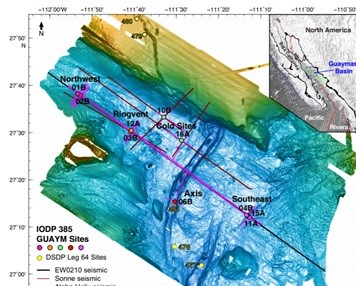- Screen Reader Access
- Skip to : main content / navigation
- Text Size
- Home
- Sitemap
- Contact us
- हिंदी
Duration: 16 September to 16 November, 2019
Port Call at: San Diego, California
Guaymas Basin is an infant-narrow ocean basin which began to form around ~5 Ma in the Gulf of California. It has two active spreading centres parallel to each other and thick piles of organic rich sediments deposited at the rate of 1000m/Ma. The active seafloor spreading produces magma as sill intrusions into organic-rich sediments which substantially alter those sediments (within an aureole with width on the order of the sill thickness) and efficiently transfer products of this alteration, including methane, CO2 and metals, to the ocean and in some cases the atmosphere.
Expedition-385 was an attempt to understand the process of submarine chemical alteration due to sediment-magma interaction, relationship between magmatism and microbial colonisation, process of hydrothermal fluid circulation and nature of magmatism in such a young ocean basin. This expedition was successfully completed in 60 days (16 Sept. to 16 Nov., 2019) with sufficient sample recovery from 7 primary sites.
Mr. S. Khogenkumar Singh from NCPOR, Goa participated in this expedition as an Igneous petrologist. His major role during the expedition was to describe the igneous cores recovered from 5 sites out of 7 by using hand lens, microscope and geochemical data generated on board. Basalt, dolerite and gabbro are the rock types recovered from the sill. Most of the basalts are vesicular, hydrothermal veins are common. Pyrite, calcite, zeolite and chlorite are found as products of secondary mineralization. Chemical analysis of carbon, methane, sulphur-sulphate, ammonia was also conducted from the sediment samples and hard rocks. High concentration of methane was observed in the depth where sill intrusions were encountered.
